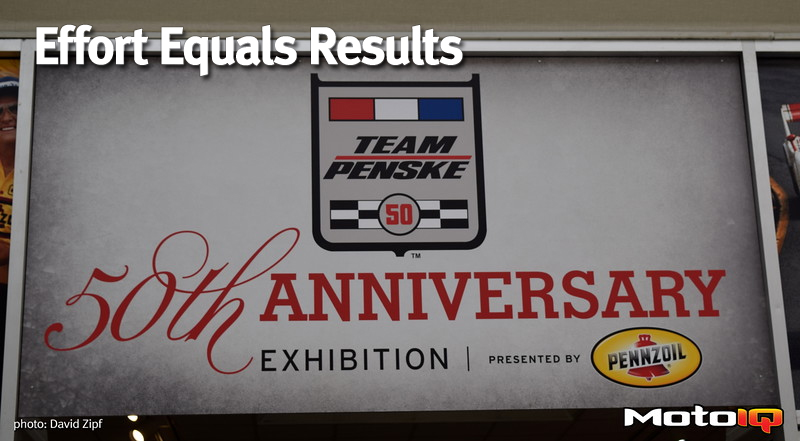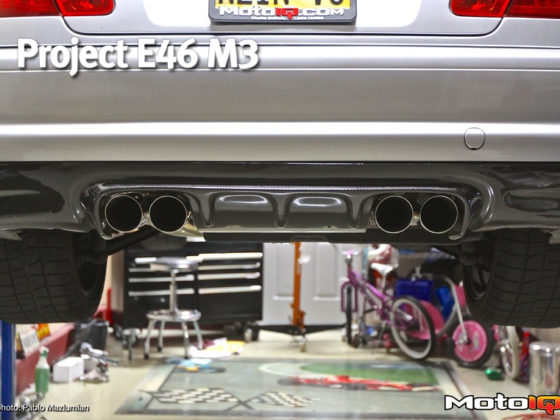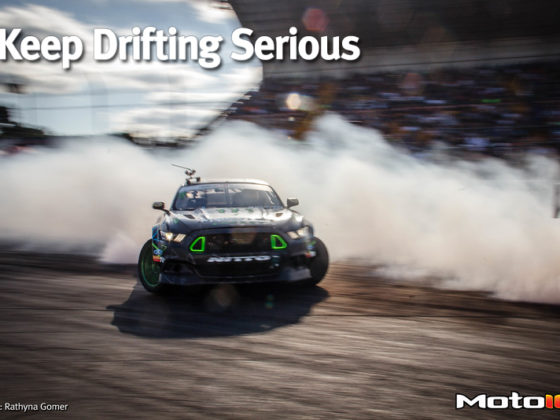,
 Bobby Unser drove this car to his third and final Indy 500 win. The race results were heavily contested because of a timing dispute (it took months of appeals before USAC gave the win to Unser) and because of the political backstabbing involved, Bobby would retire from driving at the end of the year. If you look very closely, you can see Uncle Bobby’s signature just below the “Norton” decal on the nose. Also check out the rock chips on the very tip of the nosecone: this car is completely unrestored and still wears its 35 year old battle scars.
Bobby Unser drove this car to his third and final Indy 500 win. The race results were heavily contested because of a timing dispute (it took months of appeals before USAC gave the win to Unser) and because of the political backstabbing involved, Bobby would retire from driving at the end of the year. If you look very closely, you can see Uncle Bobby’s signature just below the “Norton” decal on the nose. Also check out the rock chips on the very tip of the nosecone: this car is completely unrestored and still wears its 35 year old battle scars. By 1985, Penske had temporarily abandoned designing his own cars after a handful of mediocre years and had switched to the venerable March chassis. This particular example is a March 85C. The model number should be a dead giveaway…this was the spin and win car! In 1985, Danny Sullivan snatched the lead from Mario Andretti late in the race. As Danny cut across Mario’s nose, the turbulence upset Danny’s car and he spun out exiting Turn 1. Somehow, he was able to save the spin, performing a full 360 without touching the wall or Mario…and then went on to win the race!
By 1985, Penske had temporarily abandoned designing his own cars after a handful of mediocre years and had switched to the venerable March chassis. This particular example is a March 85C. The model number should be a dead giveaway…this was the spin and win car! In 1985, Danny Sullivan snatched the lead from Mario Andretti late in the race. As Danny cut across Mario’s nose, the turbulence upset Danny’s car and he spun out exiting Turn 1. Somehow, he was able to save the spin, performing a full 360 without touching the wall or Mario…and then went on to win the race! Another Cosworth powered car, the 85C is a future evolution of IndyCar design of its day. Even smaller wings are featured and the tunnels are even bigger (I’m pretty sure they could house a small family). To give you an idea of how large they are, just about everything behind the “M” in Miller is ground effects tunnel.
Another Cosworth powered car, the 85C is a future evolution of IndyCar design of its day. Even smaller wings are featured and the tunnels are even bigger (I’m pretty sure they could house a small family). To give you an idea of how large they are, just about everything behind the “M” in Miller is ground effects tunnel. Check out how small the side mirrors are. Drag reduction was a big priority. Also note how high the sides of the cockpit are. Unlike the PC9B, the March 85C's monocoque was mostly made from carbon fiber, though the floor was still aluminum as per CART rules.
Check out how small the side mirrors are. Drag reduction was a big priority. Also note how high the sides of the cockpit are. Unlike the PC9B, the March 85C's monocoque was mostly made from carbon fiber, though the floor was still aluminum as per CART rules. Everything in life is cyclical. Case in point is this March 86C. First, it was a racecar, driven by Rick Mears in 1986. Rick also set the closed course speed record with this car (233.401 MPH) with an early Chevy Ilmor A engine. After the season ended, this car was converted into a show car and set on display in the lobby of a Reading, PA hotel. But during the Month of May in 1987, Penske’s third driver for the Indy 500, Danny Ongais, crashed his Penske PC16 heavily and was diagnosed with a concussion. With Ongais sidelined, Roger drafted former full-time driver Al Unser Sr to drive instead.
Everything in life is cyclical. Case in point is this March 86C. First, it was a racecar, driven by Rick Mears in 1986. Rick also set the closed course speed record with this car (233.401 MPH) with an early Chevy Ilmor A engine. After the season ended, this car was converted into a show car and set on display in the lobby of a Reading, PA hotel. But during the Month of May in 1987, Penske’s third driver for the Indy 500, Danny Ongais, crashed his Penske PC16 heavily and was diagnosed with a concussion. With Ongais sidelined, Roger drafted former full-time driver Al Unser Sr to drive instead.  This car was pulled from the hotel lobby, fitted with a Ford Cosworth DFX engine (Mears and Sullivan were running Chevy Ilmors, engines that Roger had helped fund personally) and Big Al put it into the field. He then stunned the field by winning the race, his 4th 500 win. After winning the 500, it was converted back to show car status as it remains today.
This car was pulled from the hotel lobby, fitted with a Ford Cosworth DFX engine (Mears and Sullivan were running Chevy Ilmors, engines that Roger had helped fund personally) and Big Al put it into the field. He then stunned the field by winning the race, his 4th 500 win. After winning the 500, it was converted back to show car status as it remains today.


